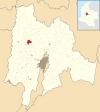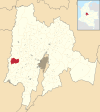Panche people facts for kids

|
|
| Total population | |
|---|---|
| 30,000 (1537) | |
| Regions with significant populations | |
| Cundinamarca, Tolima, |
|
| Languages | |
| Cariban, Colombian Spanish | |
| Religion | |
| Traditional religion, Catholicism | |
| Related ethnic groups | |
| Muzo, Muisca, Sutagao, Pijao |
The Panche (also called Tolima) were an indigenous group of people who lived in what is now Colombia. Their language is not fully understood, but it might have been related to the Cariban language family. They lived in the southwestern parts of the Cundinamarca area and the northeastern parts of the Tolima area, near the Magdalena River.
When the Spanish arrived, there were over 30,000 Panche people living in the region that later became known as the New Kingdom of Granada. Much of what we know about the Panche comes from the writings of Pedro Simón, an early scholar. He wrote that the word Panche in their own language meant "cruel" and "murderer".
Contents
Where the Panche Lived
The Panche people lived in the lower, warmer areas of the Cundinamarca region, close to the Magdalena River. Their neighbors included the Muzo to the north and the Pantágora to the northwest. To the east were the Muisca, to the southeast the Sutagao, and to the south and southwest the Pijao.
Natural boundaries like the Río Negro and Guarinó River marked their northern lands. The Coello and Fusagasugá Rivers formed their southern borders. The Panche were organized into different groups that worked together loosely. Many towns in Cundinamarca today still carry the names of these ancient Panche subgroups.
Towns in Panche Territory
Many modern towns are located where the Panche once lived. This table shows some of them:
| Name | Department | Altitude (m) urban centre |
Map |
|---|---|---|---|
| Albán | Cundinamarca | 2245 | |
| Anapoima | Cundinamarca | 710 | |
| Anolaima | Cundinamarca | 1657 | |
| Apulo | Cundinamarca | 420 | |
| Beltrán | Cundinamarca | 235 | |
| Bituima | Cundinamarca | 1627 | |
| Cachipay | Cundinamarca | 1600 | |
| Chaguaní | Cundinamarca | 1200 | |
| El Colegio | Cundinamarca | 990 | |
| Girardot | Cundinamarca | 326 | |
| Guaduas | Cundinamarca | 992 | |
| Guataquí | Cundinamarca | 227 | |
| Guayabal de Síquima | Cundinamarca | 1630 | |
| La Mesa | Cundinamarca | 1200 | |
| Nilo | Cundinamarca | 336 | |
| Nimaima | Cundinamarca | 1085 | |
| Nocaima | Cundinamarca | 1105 | |
| Pulí | Cundinamarca | 1270 | |
| Quipile | Cundinamarca | 2012 | |
| Ricaurte | Cundinamarca | 284 | |
| San Juan de Rioseco | Cundinamarca | 1303 | |
| Sasaima | Cundinamarca | 1203 | |
| Tibacuy (disputed with the zipa of the Muisca) |
Cundinamarca | 1647 | |
| Tocaima | Cundinamarca | 400 | |
| Vianí | Cundinamarca | 1498 | |
| Viotá | Cundinamarca | 567 | |
| Ambalema | Tolima | 241 | |
| Honda | Tolima | 229 | |
| Mariquita | Tolima | 495 |
Panche Culture and Lifestyle
The Panche were known as strong warriors. They often fought battles with their neighbors, the Muisca. They wore little clothing but decorated themselves with earrings, feathers, and pieces of gold.
The Panche hunted animals and fought their enemies using sticks, clubs, and arrows tipped with poison. They got this poison from spiders and snakes.
Petroglyphs (rock carvings) made by the Panche have been found in places like Tibacuy, Viotá, El Colegio, Cachipay, Albán, and Sasaima. Rock paintings have also been discovered in Tibacuy.
Like some other ancient groups in the Americas, such as the Guane, the Panche practiced cranial deformation. This means they intentionally shaped the heads of babies, often to show their social status or group identity.
When it came to burying their dead, the Panche had different customs from their neighbors. Unlike the Muisca, who buried their dead facing east, or the Muzo, who faced west, the Panche did not place their dead in a specific direction.
Panche History


The Magdalena River formed the western boundary of the Panche with the Pijao and Pantágora
The Panche civilization existed from at least 300 AD. Around the year 1000, some groups from the Caribbean coast of Colombia moved inland and settled in the region.
After the Spanish arrived and established the New Kingdom of Granada, the Panche population quickly decreased. This was mainly because they strongly resisted the Spanish conquistadores (conquerors). The first Spanish explorers to enter Panche lands were Juan de Céspedes and Alonso de San Martín. Later, Hernán Venegas Carrillo led more conquests.
Today, more than 2,000 artifacts from the Panche people are kept and displayed at the Museo del Oro (Gold Museum) in Bogotá.
Spanish Expeditions into Panche Lands (1543-1544)
Here are some of the key places and dates related to Hernán Venegas Carrillo's expeditions into Panche territory:
| Name | Department | Date | Year | Note(s) | Map |
|---|---|---|---|---|---|
| Bituima | Cundinamarca | 15 August | 1543 | ||
| Chaguaní | Cundinamarca | 1543 | |||
| Apulo | Cundinamarca | 5 January | 1544 | ||
| Tocaima | Cundinamarca | 20 March | 1544 |
Images for kids
See also
 In Spanish: Panche para niños
In Spanish: Panche para niños
































